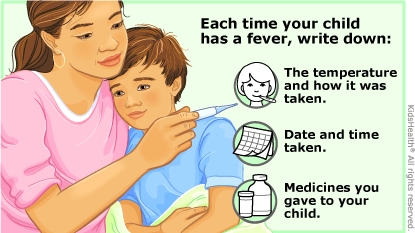Fever of unknown origin is when a child has fever for longer than a week and testing doesn't find the cause. The health care team examined your child and did tests, but they found no serious cause of the fever. Your child might have gotten fluids if dehydrated. Your child can be cared for at home. The team will continue checking for test results. Sometimes, test results that show what caused the fever come back after a patient leaves the hospital. Some fevers end without a cause ever being found. Continue to keep track of fever and other symptoms at home.



Your child:

Your child:

What causes fever? Fever in a child is often due to a viral infection (such as a cold or a stomach bug). Bacterial infections also can cause a fever. When fever comes and goes for a long period of time, health care providers look for rarer non-infectious causes. It can take a while to figure out the cause of the fever. Sometimes the fever ends with no cause found at all.
If my child feels warm, is it always fever? Not all kids who feel warm have a fever. Kids can feel warm when they are very active, play outdoors in hot weather, sleep in warm pajamas under blankets, or are upset and crying. These things make the skin feel hot because the skin is doing its job of getting rid of heat in the body. So, it's best to use a thermometer to measure a temperature if you have any concerns.
What temperature is considered a fever? Temperature taken in different ways can give different readings. These numbers are considered a fever for the type of measurement you take:
| Type of measurement | Where temperature is taken | When is the temperature a fever? |
| Rectal | Bottom | 100.4°F (38.0°C) |
| Temporal Artery | Forehead | 100.4°F (38.0°C) |
| Ear | Ear | 100.4°F (38.0°C) |
| Oral | Mouth | 100°F (37.8°C) |
| Axillary | Under armpit | 99°F (37.2°C) |
Do all fevers need treatment? No. If your child has a fever but seems well, is alert, is drinking, and is acting normally, there's no need to give medicine. But medicine can be helpful if your child is uncomfortable and not drinking well. Bringing the fever closer to a normal temperature could make your child feel like drinking, which might prevent dehydration.